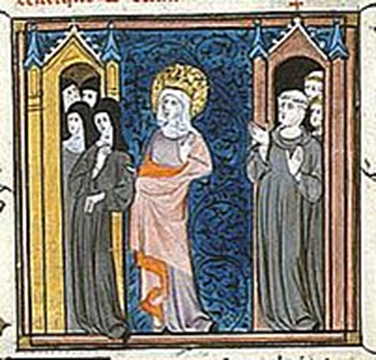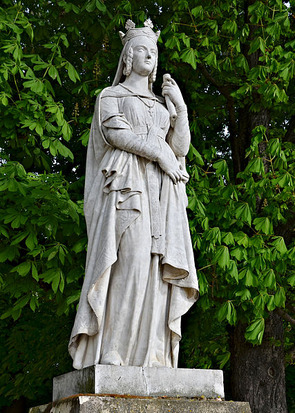 Book of Hours, Paris, ca. 1405 CE, Miniature of Bathilda founding Corbie and Chelles © British Library Royal 16 G VI folio 113v.
Book of Hours, Paris, ca. 1405 CE, Miniature of Bathilda founding Corbie and Chelles © British Library Royal 16 G VI folio 113v.
St. Bathilde, 626-680/685
Ancestral Roots Line 240A:8
Bathilde, Anglo-Saxon born but captured by Danish raiders and taken as a slave-girl to Gaul where she was placed to serve in the in the household of the mayor of the palace. While at the palace Clovis II, son of the former king Dagobert, noticed her and proposed marriage. Not the first Merovingian queen to begin her career in servitude Bathilde’s marriage to king Clovis II gave her considerable power and influence at Clovis’ court, managing the royal court and distributing charitable funds. She founded monasteries and convents and enlarged the shrines of several saints. She was loved by the people, praised for her wisdom, known for her charitable service and generous donations to the needy.
Ancestral Roots Line 240A:8
Bathilde, Anglo-Saxon born but captured by Danish raiders and taken as a slave-girl to Gaul where she was placed to serve in the in the household of the mayor of the palace. While at the palace Clovis II, son of the former king Dagobert, noticed her and proposed marriage. Not the first Merovingian queen to begin her career in servitude Bathilde’s marriage to king Clovis II gave her considerable power and influence at Clovis’ court, managing the royal court and distributing charitable funds. She founded monasteries and convents and enlarged the shrines of several saints. She was loved by the people, praised for her wisdom, known for her charitable service and generous donations to the needy.
|
Bathilde bore three sons: Clotaire III, Childeric II, and Thierry III. In 657, after 6 years of marriage, Clovis died and their eldest son, five year old Clotaire, became King with Bathilde appointed regent. She continued to minister to the people, feed the hungry, cloth the poor, bury the dead and promote Christianity. She was a capable stateswoman and as a widow of royalty she acquired legal independence, founding the abbeys of Corbie, Chellesat Chelles and Jumièges. In a society where land was communally owned but controlled by nobility and church she introduced the concept of private property proving a boon for the economy by providing a fixed place for a business, encouraging farmers to improve their land which could also be used as collateral to obtain loans.
|
During this period the poorer inhabitants of France were often obliged to sell their children as slaves to meet the crushing taxes imposed upon them. Bathilde reduced their taxes and made it illegal to buy or sell a slave in France, passing a law that any slave who was brought into the country immediately became free by paying the ransom, which she often did herself. She founded abbeys and hospitals to care for the freed slaves, gave jobs to men cultivating wild land, helped the needy by selling her jewelry and valuables, contributed to the basilica of Saint Peter and fought corruption amongst the bishops in the Church.
In 664, when her son Clotaire came of age and had ascended the throne as King of France, her two other sons were well established in their respective territories, Childeric IV in Austrasia and Thierry in Burgundy, Bathilde retired to her own royal abbey of Chelles, near Paris where she lived out her final twenty years serving in the lowliest of tasks at the abbey. It was her pleasure to take her position after the novices, serving the poor and infirm with her own hands. The Reliquary believed to have held her bones was found to contain a red cloak with yellow fringe, ordinarily forbidden by monastic rules yet someone evidentially decided that she deserved a burial appropriate to her worldly status rather than reflective of her vows taken as part of her religious profession. Her Vita Baldechildis/Vita Bathildis reginae Francorum in Monumenta Germania Historica, Scriptores Rerum Merovincarum was written soon after her death and gives great detail of her life.
In 664, when her son Clotaire came of age and had ascended the throne as King of France, her two other sons were well established in their respective territories, Childeric IV in Austrasia and Thierry in Burgundy, Bathilde retired to her own royal abbey of Chelles, near Paris where she lived out her final twenty years serving in the lowliest of tasks at the abbey. It was her pleasure to take her position after the novices, serving the poor and infirm with her own hands. The Reliquary believed to have held her bones was found to contain a red cloak with yellow fringe, ordinarily forbidden by monastic rules yet someone evidentially decided that she deserved a burial appropriate to her worldly status rather than reflective of her vows taken as part of her religious profession. Her Vita Baldechildis/Vita Bathildis reginae Francorum in Monumenta Germania Historica, Scriptores Rerum Merovincarum was written soon after her death and gives great detail of her life.
References and Further Reading
- “Bathildis.” Foundation for Medieval Genealogy. Franks, Merovingian Kings, Chapter 2 Kings of the Franks [451/157]-751, (Merovingians), Chlothachar, Dagobert , Childebert. Web. 30 May 2014. //fmg.ac/Projects/ MedLands/MEROVINGIANS.htm.
- Fell, Christine. Women in Anglo Saxon England and the Impact of 1066. British Museum Publications, 1984.
- Geary, Patrick J. Readings in Medieval History: The Early Middle Ages. Toronto Press. 2010.
- Jackson-Laufer, Guida M. Women Who Ruled: A Biographical Encyclopedia. Barnes & Noble Books, 1998.
- Koman, Alan J. A Who’s Who of Your Ancestral Saints. Genealogical Publishing Co., 2010.
- “Regent Dowager Queen Bathildis of Neustrie, Bourgogne and Austrasie (France).” Worldwide Guide to Women in Leadership, Women in Power 500-750, Female leaders and Women in other positions of political authority of independent states and self-governing understate entities. Web. 06 December 2014. //www.guide2womenleaders.com/womeninpower/Womeninpower02.htm.
- “Saint Bathildis” Our Orthodox Life. //ourorthodoxlife.blogspot.com/2010/12/saint-bathildis.html
